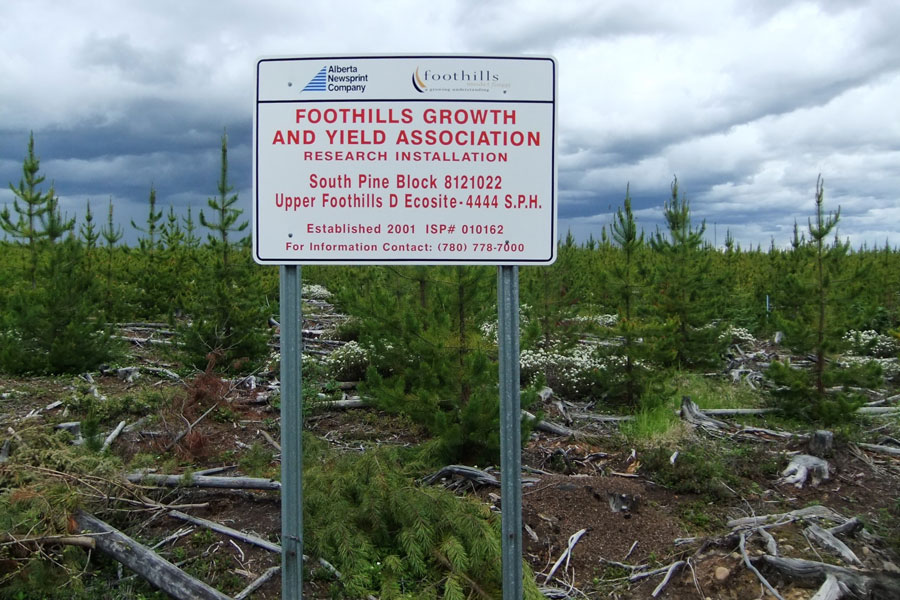It’s been 10 years since the Foothills Growth and Yield Association (FGYA) installed a unique and important long-term experimental field trial to monitor forest regeneration following harvesting throughout the Foothills region of Alberta. The trial is unique because it was designed to assess the effects of various environmental and treatment factors on the establishment, growth and survival of young lodgepole pine trees in a more rigorous and comprehensive way than had ever been attempted before. Its importance lies in the information it is providing about how the Foothills’ forests can be successfully renewed and sustained under changing management and environmental conditions that are increasingly different from those under which previous generations of trees grew up. The value of the considerable effort made to establish, maintain and monitor the trial is now being confirmed by experimental results described in the 10-year crop performance report released in February 2012 and summarized in a series of quick-notes.
Updates
- FGYA 2012-02 — Technical Report: Regenerated Lodgepole Pine Trial – 10 Year Crop Performance;
- FGYA 2012-03 — Quicknote #13: Regenerated Lodgepole PIne Trial 10 Year Results – Growth and Natural Regeneration;
- FGYA 2012-03 — Quicknote #14: Regenerated Lodgepole PIne Trial 10 Year Results – Tree Mortality and Health;
- FGYA 2012-03 — Quicknote #15: Regenerated Lodgepole PIne Trial 10 Year Results – Possible Implications for Foothills Forest Management;
Trends with potential significance for forest management, such as those listed below, were observed in natural regeneration (the establishment of trees from seed in cones left on site after harvesting) and in the mortality of planted seedlings.
- Natural regeneration of pine and other conifers was strongly influenced by soil moisture and nutrient regimes and by the amount of seed-bearing cones left on the ground after harvest. Sites with either nutrient-rich moist soils or nutrient-poor wet soils generally demonstrated poor natural regeneration. Other site classes in the trial (medium-poor nutrient regimes with moderate to good drainage) did much better, with average densities exceeding 10,000 trees per ha 10 years after harvest.
- Ingress of natural regeneration and mortality of planted stock continued beyond the 4 to 8 year age range during which regeneration establishment success is conventionally judged.
- Persistent and high levels of mortality in planted stock occurred, particularly on warm low-elevation sites with either rich nutrient regimes or drier soils. A strong relationship was found between mortality and mean annual temperature of the site.
- Interestingly, in spite of the observed relationship to temperature, few tree deaths were directly attributed to climatic injury. The primary causes were common diseases and insects affecting tree roots. Increased temperatures or related changes in other climate variables may be increasing the susceptibility of young trees to these pathogens and / or increasing pathogen activity.
Possible management adaptations might include:
- Reduced reliance on planting of lodgepole pine too soon after harvest when opportunistic pathogens like root diseases and root collar weevils are most abundant and when trees physiologically stressed by planting, climate or other factors are most likely to succumb to them;
- Improved assurance of natural regeneration to offset mortality risks e.g. slash spreading on cutover areas where trees have been topped and de-limbed at roadside, as necessary to achieve adequate distribution of cones and seeds;
- Planting of problem pine sites (that don’t naturally regenerate easily to lodgepole pine) with alternative species or with pine in mixture with other species;
- Caution in interpreting the results of conventional early establishment surveys, and improved linkage between the results of these surveys and reforestation standards based on later performance.
- Adjusted deployment of planted stock, matching seed sources to out-planting sites on the basis of current and future (versus past) climate conditions.







